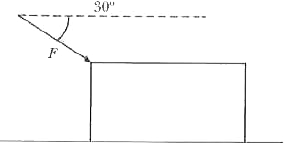If the normal force is doubled, the coefficient of friction is
Not charnged
Halved
Doubled
Tripled
To solve the question, "If the normal force is doubled, the coefficient of friction is:", we need to understand the relationship between the normal force, the frictional force, and the coefficient of friction.
1. Understanding the Normal Force:
The normal force (N) is the force exerted by a surface to support the weight of an object resting on it. It acts perpendicular to the surface.
2. Frictional Force Formula:
The frictional force (F_friction) can be expressed as:
Ffriction=μ⋅N
where μ is the coefficient of friction, and N is the normal force.
3. Doubling the Normal Force:
If the normal force is doubled, we can express this as:
N′=2N
where N′ is the new normal force.
4. Effect on Frictional Force:
Substituting the new normal force into the frictional force equation gives:
F′friction=μ⋅N′=μ⋅(2N)=2μ⋅N
This shows that the frictional force will double if the normal force is doubled, assuming the coefficient of friction remains constant.
5. Coefficient of Friction:
The coefficient of friction μ is a property of the surfaces in contact and does not change with the normal force. It is determined by the materials of the surfaces in contact and their condition (smooth, rough, etc.).
6. Conclusion:
Since the coefficient of friction μ is independent of the normal force, if the normal force is doubled, the coefficient of friction remains unchanged.
Final Answer:
The coefficient of friction is unchanged.
The normal force (N) is the force exerted by a surface to support the weight of an object resting on it. It acts perpendicular to the surface.
The frictional force (F_friction) can be expressed as:
Ffriction=μ⋅N
where μ is the coefficient of friction, and N is the normal force.
If the normal force is doubled, we can express this as:
N′=2N
where N′ is the new normal force.
Substituting the new normal force into the frictional force equation gives:
F′friction=μ⋅N′=μ⋅(2N)=2μ⋅N
This shows that the frictional force will double if the normal force is doubled, assuming the coefficient of friction remains constant.
The coefficient of friction μ is a property of the surfaces in contact and does not change with the normal force. It is determined by the materials of the surfaces in contact and their condition (smooth, rough, etc.).
Since the coefficient of friction μ is independent of the normal force, if the normal force is doubled, the coefficient of friction remains unchanged.
The coefficient of friction is unchanged.
Topper's Solved these Questions
Similar Questions
Find the work done by the frictional force in drawing a circle of radius r by a pencil of negligible mass with a normal pressing force N ( coefficient of friction μk).
View SolutionA block of mass m slips on a rough horizontal table under the action of horiozontal force applied to it. The coefficient of friction between the block and the table is μ. The table does not move on the floor. Find the total frictional force aplied by the floor on the legs of the table. Do you need the friction coefficient between the table and the floor or the mass of the table ?

View Solution
Knowledge Check
If the normal force is double, then coefficient of friction is,
AHalvedBTripledCDoubledDNot changedIf the normal force is doubled, the coefficient of friction is
AHalvedBDoubledCTripledDNot changedA block is in limiting equilibrium on a rough horizontal surface. If the net contact force is √3 times the normal force, the coefficient of static friction is
A√2B1√2C0.5D1√3
If normal force becomes two times, then coefficient of friction
View SolutionA block is sliding on a rough horizontal surface. If the contact force on the block is √2 times the frictional force, the coefficient of friction is
View SolutionA 250 N force is directed horizontally as shown in the figure to push a 29 kg box up an inclined plane at a constant speed. Determine the magnitude of the normal force, FN and the coefficient of kinetic friction, μ2

View SolutionIf the normal reaction is doubled, the frictional force is _______
View SolutionA force of F = 12.0 N is applied to a 8.00 kg block at a downward angle of 30∘ as shown in the figure.

The coefficient of static friction between the block and the floor is 0.700 and the coefficient of kinetic friction is 0.400. What is the magnitude of the frictional force on the block?
View Solution